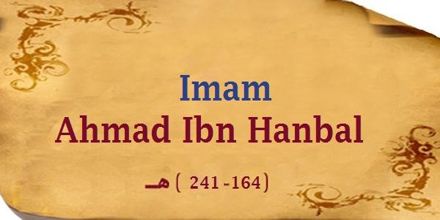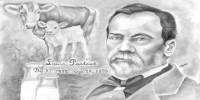Imam Ahmad Ibn Hanbal (164–241 H)
Title: Sheikh ul-Islam
Born: Rabi-ul-I, 164 AH/November, 780; Baghdad, Iraq
Died: 12 Rabi’-ul-I, 241 AH/ 2 August, 855(aged 74-75); Baghdad, Iraq
Era: Islamic Golden Age
Occupation: Scholar of Islam
Main interest(s): Fiqh, Hadith, Aqeedah
Notable idea(s): Hanbali madhhab.
Ahmad Ibn Hanbal was a founder of one of the four main Sunni schools of Jurisprudence. He developed fiqh but was also an expert in the study of Islamic oral traditions (the sayings – hadith). He famously and heroically held true to his beliefs despite the pressures of a Caliph who wished to impose his philosophical ideas on Islam.
The Abbasid Caliph, Al-Mutawkkil was a strong admirer of Imam Ahmad ibn Hanbal. He once sent him some rich gifts, including a large amount of money. A highly placed official at court, who wished Ahmad well, wrote to him that the gift was forthcoming and alerting him that, should he refuse it, there would be no shortage of people who would be quick to try to use that in order to sow discord between him and the Caliph. Nevertheless, Ahmad did not allow any part of the gift to enter his home. He distributed it all to poor and needy people, taking nothing for himself or his family.
Thus was Ahmad ibn Hanbal: a model of courage and honesty who cared little for worldly comforts and luxuries that money may buy. What a Caliph would give held no temptation for him. Yet he did not consider taking such a gift to be forbidden. His son once asked him whether he could offer the pilgrimage using money he received from the Caliph. He answered that he could, because it was money obtained from a legitimate source, explaining that he would not take it himself, as he wished to maintain a standard of purity that he imposed on no one else. If such an attitude was certain to ensure great fame for the scholar, let us now look into his life.
Early Life
Ahmad memorised the Quran at an early age, and as he was directed by his uncle and his mother to pursue his studies, his serious nature and early pious attitude ensured that he sought to study Fiqh, or Islamic jurisprudence. Baghdad was at the time not only the political capital of the vast Islamic state, stretching from the Atlantic in North Africa to Central Asia; it was also the most important centre of Islamic scholarship, witnessing at the same time the penetrating influence of other cultures, including Greek philosophy, Indian mythology and Persian traditions. Ahmad sought none of this, but went straight into the study of Fiqh, reading under Abu Yussuf, the best known student of Abu Haneefah. This means that his early studies took him into learning Fiqh that gave scholarly discretion a very high rank and relied much on analogy. But soon afterwards, he decided to pursue the study of hadith, delaying Fiqh study for a while.
Ahmad started his pursuit of the study of hadith in Baghdad at the age of 15, and continued to give it his full attention there for seven years. He realised that the main scholars of hadith did not all live in the capital. So he decided to seek them wherever they lived. He began to travel to Basrah, Kufah, Hijaz and Yemen. He is said to have travelled five times to Basrah, and paid a similar number of visits to Hijaz. However, in the latter trips he combined offering the pilgrimage with his studies.
On all these trips, Ahmad’s aim was to listen to the Prophet’s hadiths from scholars personally. He could have easily learnt the hadiths from their books, but he was keen to listen to their hadiths as they personally reported them. That is a recognised virtue of excellence in the scholarship of hadith, because it ensured a smaller number of reporters in the chain of transmission of a hadith between the student and the Prophet himself. A shorter chain of transmitters, who were all reliable and trustworthy, meant the room for error is practically non-existent. Hence, scholars were keen to seek a hadith at the shortest chain of transmission they could achieve, even though that might have required them to undertake a long journey.
Up to this stage, we recognise two major influences on Ahmad’s scholarship: the early study of Fiqh under Abu Yussuf and the hadith study through which he collected a wealth of statements by the Prophet, or hadiths, together with rulings by the Prophet’s companions and their successors as well as their judgements in disputes put to them. This represented a strong exposure to the practical application of hadith and other religious text, which means that he was not isolated from Fiqh during his study of hadith. However, a third influence was soon to have a major bearing on Ahmad and his scholarship. That was his meeting with El-Shafie who by that time had developed his methodological approach to Fiqh and the fundamental rules he set for construction and deduction of rulings and judgements. When he studied under El-Shafie, Ahmad started to review what he had learnt and collected of hadiths and reports of the Prophet’s companions and their successors so as to pinpoint the relevance of those texts and reports to practical matters. That gave him a profound insight in Fiqh which was rare among scholars of hadith. Thus, Ahmad was at the same time a top scholar of hadith and a top scholar of Fiqh. That combination gave him a rare standard of excellence.
Teachers and Students of Imam Ahmad
He learned and wrote hadith from Imam Ash Shafi’i, Hushaim, Ibrahim Ibn Sa’d, Sufyan Ibn Uyaina, Abbad Ibn Abbad, Yahya Ibn Abi Zaidah, and from other scholars at their time. The teachers he cited only for the book Al Musnad alone, were more than 280 people. Whereas his senior students were Bukhari, Muslim, Abu Daud, Abu Zur’ah, Mathin, Abdullah Ibn Ahmad Ibn Hanbal, Abul Qasim Al Baghawi, and many more.
Praises for Imam Ahmad Ibn Hanbal
If we compiled praises of the scholars for Imam Ahmad, it would make a book itself. Due to the great number of his virtues and excellences, Imam Adz Dzahabi wrote about his biography in his work, Siyar A’lam An Nubala, from page 177 until 358. Beside him, many other scholars had written his biography in a distinct book, such as Imam Baihaqi and Ibn al Jauzi who wrote about his biography in one thick volume, whereas Sheikh al Islam Al Anshari wrote about his biography in several, thinner, volumes.
It indicates his excellences and his prominent position among muslims. Here are some praises of the scholars for him:
- From Abdillah, that he heard that Abu Zur’ah said, “Your father (Ahmad) memorized one million hadith.”
- From Hanbal, that he heard that Imam Ahmad said, “I memorize everything that I’ve heard from my teacher, Hushaim, during his life.”
- Ibrahim Al Harbi said, “I’ve seen Imam Ahmad. Allah has gathered in him knowledges of the past and present people.”
- Imam Ash Shafi’i said, “When I left Baghdad, I didn’t leave a nobler, smarter, and cleverer man than Ahmad Ibn Hanbal.”
- Ali Al Madini said, “Indeed, Allah has strengthened this religion with Abu Bakr Ash Shiddiq on the day of Riddah (when people returned to infidelity) and Allah has strengthened this religion with Ahmad Ibn Hanbal on the day of mihnah (when people were forced to say that the Qur’an is creature).
Trials for Imam Ahmad
At the time of Caliph Al Makmun, the muslims were tried by the ideology of Mu’tazila. They were forced to say that, “The Qur’an is creature.” Whoever among the public figures refused to say that the Qur’an is creature would be killed or prisoned. Saleh, the son of Imam Ahmad said, “All scholars admitted that the Qur’an is creature but four people: my father, Muhammad Ibn Nuh, Al Qawariry, and Al Hasan Ibn Hammad. Finally, Al Qawariry and A Hasan Ibn Hammad admitted that the Qur’an is creature. The rest, my father and Muhammad Ibn Nuh, were imprisoned for several days.” (See: “Siyar A`lam An-Nubala’”, page 238)
Imam Ahmad stood strong to defend the creed of ahlu sunnah wal jama’a, that the Qur’an is the word of Allah, and not a creature. After Al Mutawakkil became a caliph, Imam Ahmad was ennobled by the kingdom, to the extent that none of the juries and authorities were appointed before being consulted to Imam Ahmad.
The works of Imam Ahmad
Imam Ahmad had plenty of writings. Among his works are:
- Al Musnad. In this book, he collected many hadith based on the list of names of the narrator from the generation of the companions. This book contains 30.000 hadith.
- Resala Shalat. he wrote this small book as a part of his advices regarding mistakes of congregatory prayer performed at the mosque near his house.
- Al Masail. This book is a collection of fatwas issued by Imam Ahmad from the question of his son and his students. Thus there were many volumes of Al Masail based on the names of the questioner. For example Masail Abdullah, which contained the questions and answers between Imam Ahmad and his son, Abdullah; Masail Abu Daud, contained questions and answers between Abu Daud and Imam Ahmad.
- Al Ashriba. This book contains his explanations regarding intoxications and definitions of unlawful beverage.
- Fadhail Ash Shahabah. This book contains indications about the virtues of the companions. Basically, this book is a rebuttal for the Rafidha who claimed that majority of the companions were kufr.
The death of Imam Ahmad
He died on Friday, 12th of Rabi’ul Awwal, 241 Hijri, at the age of 77 years. When he died, many people prayed for his corpse. It was told by Adz Dzahabi, from Bunan Ibn Ahmad Al Qashbani that he attended the funeral prayer for Imam Ahmad, and people who prayed for Imam Ahmad were about 800.000 man and 60.000 woman. In another narration, from Abu Zur’ah, he received the news that Caliph Al Mutawakkil ordered someone to count the foot traces of people who prayed for the corpse of Imam Ahmad. It was told that the number of traces were more than 2.500.000 people, who prayed for him. May Allah have mercy on Imam Ahmad Ibn Hanbal.
















